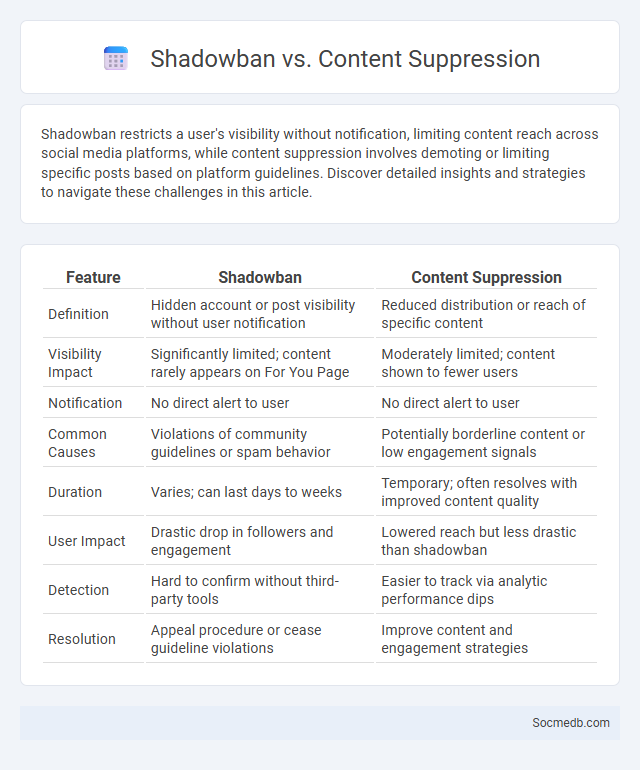
Photo illustration: Shadowban vs Content Suppression
Shadowban restricts a user's visibility without notification, limiting content reach across social media platforms, while content suppression involves demoting or limiting specific posts based on platform guidelines. Discover detailed insights and strategies to navigate these challenges in this article.
Table of Comparison
| Feature | Shadowban | Content Suppression |
|---|---|---|
| Definition | Hidden account or post visibility without user notification | Reduced distribution or reach of specific content |
| Visibility Impact | Significantly limited; content rarely appears on For You Page | Moderately limited; content shown to fewer users |
| Notification | No direct alert to user | No direct alert to user |
| Common Causes | Violations of community guidelines or spam behavior | Potentially borderline content or low engagement signals |
| Duration | Varies; can last days to weeks | Temporary; often resolves with improved content quality |
| User Impact | Drastic drop in followers and engagement | Lowered reach but less drastic than shadowban |
| Detection | Hard to confirm without third-party tools | Easier to track via analytic performance dips |
| Resolution | Appeal procedure or cease guideline violations | Improve content and engagement strategies |
Introduction to Shadowban, Content Suppression, and Shadowbanning
Shadowban refers to a covert restriction imposed by social media platforms that limits the visibility of a user's content without their knowledge, often as a response to perceived violations of community guidelines. Content suppression involves algorithms or manual moderation tactics that reduce the reach and engagement of posts, diminishing their appearance in followers' feeds or hashtag searches. Shadowbanning specifically targets accounts by hiding or limiting their content, effectively reducing social interaction and discovery while maintaining the facade of normal account operation.
Defining Shadowban: What It Is and How It Works
A shadowban is a social media restriction that limits your content's visibility without notifying you, effectively hiding posts from broader audiences while maintaining normal account access. Platforms use algorithms to detect behaviors violating guidelines or spam-like activity, triggering shadowban measures that reduce engagement and reach. Understanding how shadowbans work helps you adjust your content strategy and avoid actions that could inadvertently lower your profile's exposure.
Content Suppression Explained: Mechanisms and Impact
Content suppression on social media involves algorithms and platform policies that limit the visibility or distribution of posts deemed inappropriate, misleading, or harmful. Mechanisms such as shadow banning, reduced reach, and de-indexing work to control the spread of content without outright removal. This suppression significantly impacts user engagement, freedom of expression, and the overall information ecosystem by shaping what content is accessible and influential.
Shadowbanning Demystified: Key Characteristics
Shadowbanning on social media involves restricting a user's content visibility without their knowledge, significantly reducing reach and engagement. Key characteristics include hidden content suppression, lack of notification, and reduced interaction metrics, which often leads to user frustration and confusion. This covert action typically targets accounts violating platform guidelines, aiming to limit misinformation or harmful behavior while avoiding direct confrontation.
Comparing Shadowban, Content Suppression, and Shadowbanning
Shadowban limits the visibility of Your content by making it undiscoverable to others without your knowledge, often applied quietly by platforms to enforce guidelines. Content suppression involves reducing the reach or prominence of posts, typically seen in algorithms that deprioritize certain topics or accounts based on community standards. Shadowbanning is a broader term encompassing both shadowban and content suppression practices, aimed at restricting user engagement without transparent notifications.
Signs You’re Experiencing Shadowban or Content Suppression
A shadowban on social media platforms often results in a sudden drop in engagement, such as fewer likes, comments, and shares, despite consistent posting habits. Content suppression may manifest as reduced visibility in hashtag searches, limited reach in followers' feeds, and exclusion from platform recommendation algorithms. Monitoring follower activity and using analytics tools can help identify these signs early to adjust content strategy accordingly.
Platform Policies: How Different Networks Apply Restrictions
Platform policies on social media vary significantly, with networks like Facebook, Twitter, and Instagram implementing distinct content moderation rules based on community guidelines and legal requirements. Each platform employs automated systems and human reviewers to enforce restrictions on hate speech, misinformation, and harmful content, ensuring safer user experiences. Understanding these policies helps you navigate posting limits and content visibility across different social media environments effectively.
Reasons Behind Shadowbanning and Content Suppression
Shadowbanning and content suppression on social media often occur due to violations of community guidelines, such as spreading misinformation, hate speech, or spammy behavior. Algorithms prioritize user experience by reducing the visibility of posts deemed harmful or misleading to maintain platform integrity. These practices help control the proliferation of unethical content but may also lead to debates about transparency and censorship.
Strategies to Detect and Overcome Visibility Restrictions
Social media platforms implement visibility restrictions through algorithms that limit your content's reach based on engagement patterns and community guidelines, making it essential to analyze performance metrics like impressions and reach regularly. Developing a strategy that includes consistent posting schedules, diversifying content formats, and leveraging hashtags aligned with your niche can counteract algorithmic suppression and increase organic visibility. Monitoring feedback and adapting your approach to comply with platform policies while encouraging genuine interactions helps you overcome shadow bans and maintain audience growth effectively.
The Future of Online Moderation: Transparency and User Rights
The future of online moderation hinges on enhancing transparency and safeguarding user rights through clear guidelines and accountability mechanisms. Platforms are increasingly implementing AI-driven tools combined with human oversight to ensure fair content evaluation while respecting free expression. Your experience will improve as companies adopt open moderation policies, allowing you to understand decisions and appeal unfair actions effectively.
 socmedb.com
socmedb.com